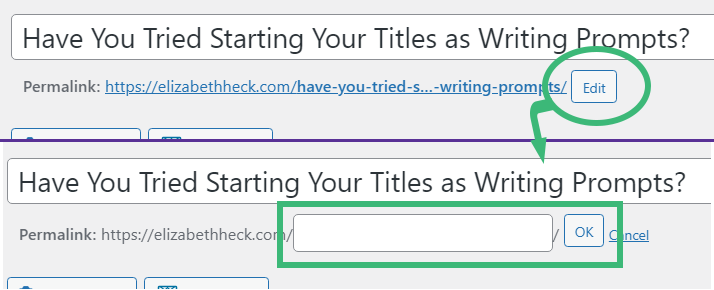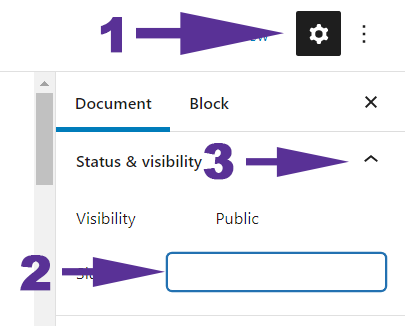Have You Tried Starting Your Titles as Writing Prompts?
When do you write your title? Last? I’m sure you’ve heard that saying before and I didn’t get it. Turned out I was calling my writing prompts “titles”. To be completely honest I’m not sure the saying applies to content writing or blog articles. I’ve found the more often you write the easier it becomes for your initial ideas to end up being your title.
Fleshing out the initial idea or writing prompt early on can help keep you on the topic as you write. You can look back to the title to make sure you haven’t veered too far down a tangent. This has been helpful to me as sometimes I’ll get caught up and add a story that doesn’t help convey the current topic.
Oh! Real quick, don’t make the same mistake I’ve made countless times in the past.
If you are matching your URLs to your Titles please make sure they get updated when you make changes. These quick tips are for WordPress.

If you use the classic editor plugin for your writing then click the edit button next to the URL. Highlight all of the text in the box and delete it. Hit OK and WordPress will automatically fix the URL for you.

If you’re using Gutenberg editor (the new default) then you’d click the gear icon (#1 in the pic) in the upper left area. Then select the text in the box (#2 in the pic) and delete it. Last you toggle the show/hide arrow (#3 in the pic) and WordPress automatically fixes the URL for you.
After Your Title, You Expand on Takeaways
Best of all once you have your title settled at least to writing prompt level you can work on the excerpt and outline. The excerpt helps with SEO and it can help you come up with your intro. Also, it can serve as your meta description so keep it short and sweet. 140-160 characters is a good range.
Sidenote: Your article’s actual intro doesn’t have to be limited. Just the excerpt/meta description.
Now when it comes to outlining the post I like to think about what I want the reader to take away once they’re done. Those takeaway points are the start of my post outlines. Added bonus they usually end up being great subheadings (h2s) for your article.
What’s a good amount?
Great question, generally it depends on the topic but aiming for 2-3 is a great way to look at it. For complicated topics you can go beyond that just keep in mind you might be fluffing your article. If you don’t feel that way then consider breaking up the article into multiple posts. I should mention, this is a bit tricky as word count will be a factor when deciding if you’ll want to break up the post.
Takeaways Done! Now Pick 3 Points
Why 3? Because it’s a magic number! There’s a lot of instances where that idea comes into play. In this case 3 because of the writing principle “rule of three.” It suggests that 3 events/topics/points are more satisfying or effective.
It works well with a lot of potential points you’d want to bring up about your takeaway. 1 reason is weak, 2 is better, 3 is believable and strong. 4 could work but it does being to feel like you’re starting to get a little long on reasons. Stories have a beginning, middle, and end.
If you want to keep the trend going you can even aim to write 3 sentences for each point. Also, depending on the topic these 3 points can serve as sub subtopics headings too. You can see this a bit further up with the question, “What’s a good amount?”
Takeaways and Points Check! Add in Some Media
There’s “farmed” media which is okay. Then there is “personal” media which is better. Either way, the goal of adding in some media is to break up large chunks of text with contextual media.
I will say while it isn’t media per se white space is a very useful tool when it comes to breaking up chunks of text. Think about white space such as line or paragraph breaks as conversational pauses.
What is “farmed” media?
Stock images or images referencing other elements. An example of this can be seen in my posts. I occasionally will use seemingly generic images or GIFs (still won’t call ’em JIFFs).
There are two keys to making this a better choice, first, opt for media that has a personal element. I grew up watching a lot of Simpsons hence sourcing from that show a lot. The second making sure it is relevant to the topic or at least ironically irrelevant.
Didn’t you just make “farmed” media personal?
While a personalized touch could imply that, it isn’t the same. What is meant by personal media is something you’ve created specifically for the post. An example is the images I used in the intro of this post. I made them, specifically to help with the point of updating your URLs. They also go along with a personal story where I would forget to update my URLs when I started out.
Now Let’s Wrap It Up!
To go along with having an intro you should have a few closing thoughts. You should quickly sum up how the takeaways help convey the topic of the post. Don’t forget to reiterate your stance on the topic.
Review your intro and excerpt to make sure they are still relevant to the article as a whole. Make any necessary changes and you’re all set.
I hope this helps anyone who might be new to writing content or was looking for a way to speed up their writing. It has been a great help for me and best of all the more I did it the faster it becomes second nature.
Well, Crap I Almost Forgot! The Call to Action!
A Call to Action(CTA) can be anything from linking to a product or asking your readers to share their thoughts. Depending on the topic or goal the CTA might fit better sprinkled into the article and reaffirmed at the end.
In the case of this article my call to action is:
Here’s a blog post writing template I built for a client that you can have for free. Click on the preview image for the file.
No catch, well unless you count reading this far or scrolling 🙂
If you find it useful, tell me because I would love to hear about it.
Every comment will help.


Share your thoughts!